Foreword by J Thomas
It was a pleasure working with Dave Sood. He already had solar photo voltaic panels on his roof, thus proving that he was receptive to new ideas. His niece and staff were also clueful and enthusiastic people. They quickly and intelligently discussed the issues with Dave and implemented the ideas.
The first major rain swept away some of the bunds, thus demonstrating that we need to treat water with respect. Niece and staff quickly repaired and strengthened the bunds.
It helped that Dave’s farm gets some water from the high ground to the south. Earlier, this water used to go waste. Capturing this water is equivalent to living in a higher rainfall area. A huge bonus.
One day, a friendly black cobra came from the Asola wildlife sanctuary. He was captured in a sack and taken back to the wildlife sanctuary. He was obviously attracted by the increased activity in Dave’s backyard. The black cobra is the mascot of my old squadron and I took it as a good omen.
The ultimate aim of the exercise is to attain freedom from tanker water. My guess is that the work done so far will reduce tanker requirement next year by half. It also depends on the quantum of winter rains. If they are copious, we may even attain complete freedom from tanker water. We need to wait and see.
*
Towards Freedom from Tanker Water in Chattarpur, Delhi
by
Dave Sood
A course mate of mine Surjit runs a friendly e-magazine called ‘amolak.in‘. I have been reading articles written by various authors on most varied subjects.
I was vacationing in New York in the month of June when I read an article written by Joe Thomas, another course mate of mine from Indian Air Force, on water harvesting. He had used his knowledge in improving the water levels in the gated community that he resides in Bangalore.
It was fascinating to read that within a year, he had managed to bring the water levels of that area to a reasonably height. This enable the colony to use their water wells for drinking as well as in maintaining the lawns of the society. This is in comparison to the neighboring societies which are still running on tankers.
This article made me look at my own place of residence in New Delhi in Asola which is next to a wildlife sanctuary in Delhi. I have a total of 12000 Sq. mtrs and I depend on tankers every year from March to July. The relief only comes in July when rain happen and the water level comes up to a reasonable height for the well to operate.
I wrote to Joe in Bangalore and also exchanged many calls on whats-app regarding my water scarcity.
He asked me for the exact pin point location on Google maps and a general layout of the area. It was amazing that we were conversing this when I was staying in New York; Joe was in Bangalore and my niece who stays with us at the farm in Delhi, providing all the answers.
From all the conversations I concluded that:-
-
A land size of 12000 Sq. Mtrs gets an average rainfall during monsoon of 300 mm. This gives me a total volume of 36,00,000 liters of water in my area. There are ways to control this water by making various bandhs in the farm to ensure that water seeps within the parameter of the farm.
-
My farm has various levels and it is easy for the water to run out of the farm into the Asola Wildlife Sanctuary. This had to be stopped so that the water seeps in the area where it is falling.
-
Extra water can be collected from the road and the farms which is higher than my grounds.
-
Any water that I collect in my farm, beyond the 50% line of my farm is actually used by Asola Wildlife Sanctuary. The underground aquifers running at the farm beyond the 50% mark normally will flow to the lower slopes towards to Asola Wildlife Sanctuary.
Based on these directions I made a sketch of the farm and gave my comments, ideas as to how we should make the bandhs to retain the water in our area.
Sketch of the farmhouse, based on Satellite Imagery
My niece was very enthusiastic about this project and started making bandhs at various levels as explained. By now we were at the end of the month of June and rains were expected in the first week of July.
She spent approximately Rs.40,000 in labor, bricks and mortar to make these bandhs. This help in retaining the water as planned.
The rain got delayed by about ten days and that gave us additional time to complete and make firm bandhs as per the drawing. We continued to exchange photographs between my niece and Joe to confirm that we are on the right lines to collect all the water in the farm.
After the rains of July Joe was very keen to know the result of our water harvesting. I was glad to share with him that the water levels had gone up in the farm. It used to take 12 hours of pumping water from the well to fill all the tanks in the farm (running the pump for one hour and giving it a rest of one hour through the night). After harvesting we could fill all the tanks by running the pump only for two hours continuously. This is a major achievement of this project and I was extremely happy to see the results.
This whole project was different from the water harvesting project preached by the Delhi Jal Board. They expect you to have one area where you will dig a large pit approximately 10 feet deep and fill it with different grade of soil, sand and stones. The water will seep in this area only. I cannot imagine the quantity of water that we get can be soaked in this pit only. Joe clarified that this method is meant for densely populated urban areas. In our case, there were more than 3 acres of garden area which was ample for absorbing the rain water of 36 lakh litres during the monsoon.
It was a very good lesson in water harvesting. Right now Joe is encouraging me to circulate this plan of water harvesting so that the general level of water in my area surrounding the farm goes up which will help us ultimately.
We had a RWA meeting on September 22, 2019 and I discussed the same with the fellow farm owners. About half of them said that they get adequate water from their borewells. The others have expressed a desire to see things for themselves.
Joe has been very kind in sharing his thoughts and giving his precious time to guide us through the developments of the farm for collection of rain water.
I am sharing some of the diagrams and pictures of the bandhs that we made to show you how and where the bandhs were created to retain the water at the farm
Great thanks to AMOLAK to have printed Joe’s article on water harvesting which encouraged me to do the same at my Farm with his guidance
Thank you Joe
Thank you Surjit for the great e-magazine that you run.
Before we turn to the picture gallery, let us see a portrait of the author, to help you in placing Dave Sood.
And now, here are a few pictures that tell the story pictorially.

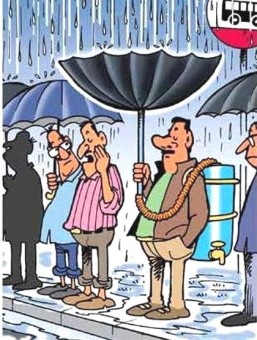

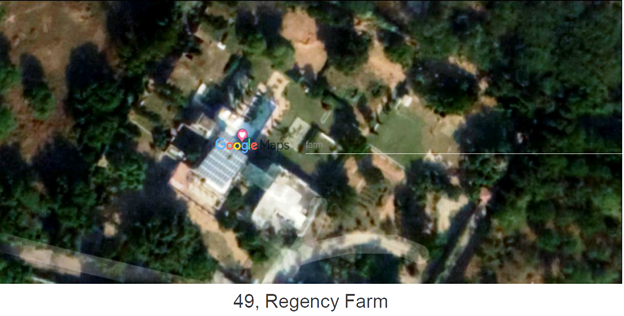


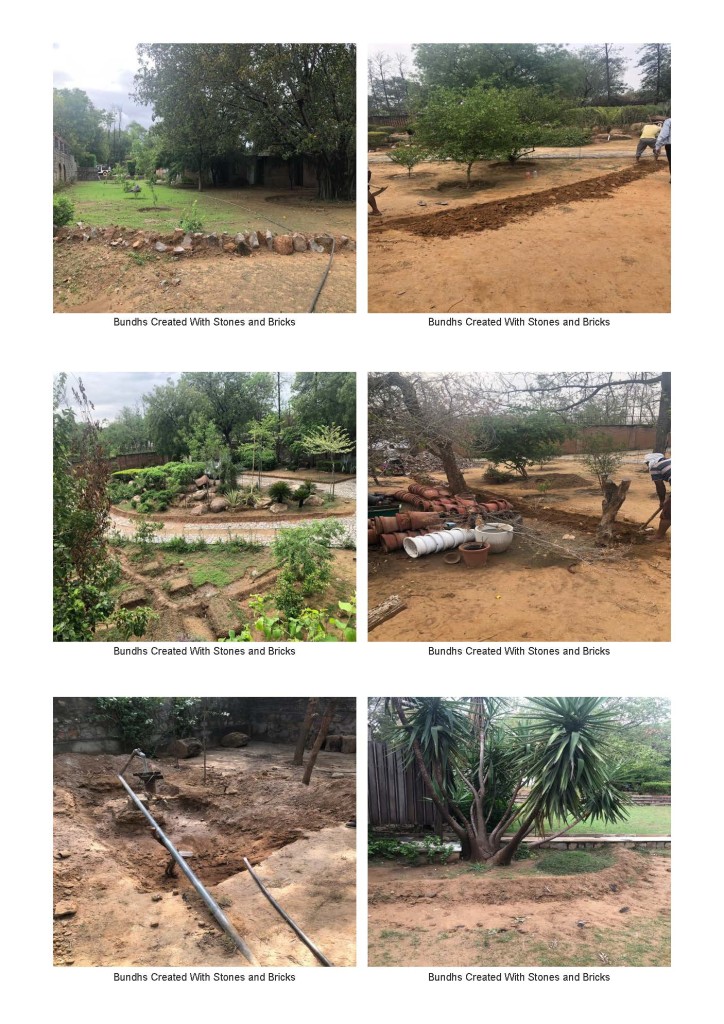
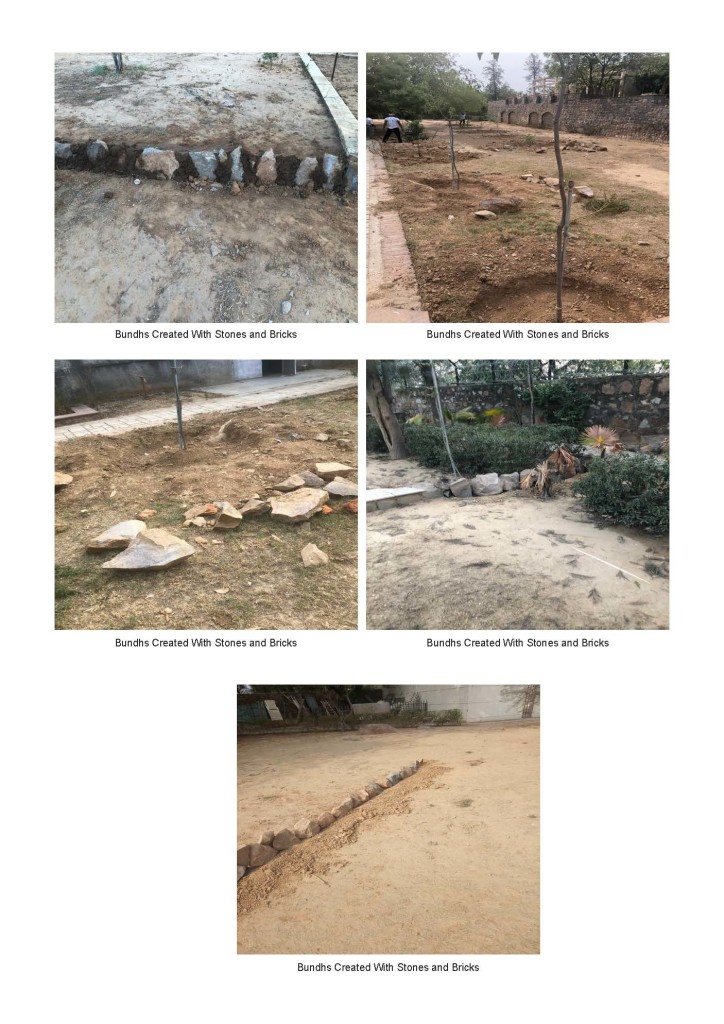

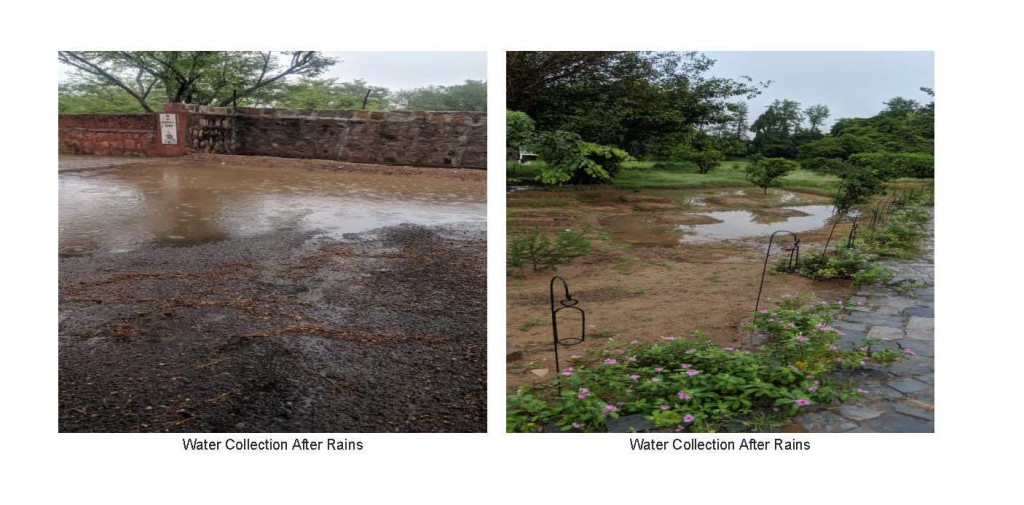






I read the water harvesting article with great interest. The results speak for themselves and kudos to all concerned.
I got interested in water harvesting when I spent a year in Australia for the NDC equivalent course. One of my friends, a hard core white Aussie, had a 12 acre farm east of Canberra. That part of the country is very dry and often faces drought conditions. Like most Aussie farm owners, he too had dug several ponds, in 2-3 tiers, with bunds on the lower lip. Much of the rain water so trapped would soak into the ground. The rest was used to irrigate his orchards.
What really attracted me was his 3000 sq ft home in which almost the entire basement was a water tank with a capacity of about 125,000 litres. This was replenished through rooftop harvesting of rain water. Once the tank was full, it served the internal needs of the home (mainly kitchen and toilet) for over a year.
15 years later when I was constructing a farm house outside Pune, I decided to do something similar, but on a smaller scale. The storage tank was constructed at the time of making the foundation. It’s capacity is 65,000 litres. The rainfall in that area is around 800mm per year (mainly during the 4 month monsoons) which adds up to about 1,60,000 litres from the 200 sq m rooftop. A bathtub sized filtration enclosure removes most solid particles that may come down the gutter. Usually, by mid July the tank is full and the overflow is automatically routed into a bore well on the property.
The net result is that for the two occupants of the house, each using about 125 litres per head per day (WHO norms), we have enough soft water for 8 months – and complete freedom from tankers. The quality of water is superb, though as a matter of abundant caution we use a non-RO filter for cooking and drinking.
Several of my acquaintances have copied the general design, which raises the cost of construction only marginally.
The water from the driveway and the rest of the 1,500 Sq m land is also guided towards a second bore well which happens to be near the lowest point of my property. In all, I estimate I’m putting in about 1.5 to 2.0 lakh litres per year back into the ground.
Will give more details if you are interested.
Thanks a lot for sharing.
Warm regards
Hari
ABS Sidhu
2:24 PM (2 hours ago)
to me
Thanks for sharing very useful idea
of rain harvesting .
This can be easily done in the compound
of large Bungalows / Farm houses . However
this is difficult on agri farms , because if water
stand in the field for longer periods ,it may damage
the standing crops.
With warm regards .
ABS Sidhu
Thanks ABS. You have a valid point about waterlogging. Plants and trees will die if they are subjected to waterlogging. The period varies with the plant species but 24 hours can be taken as a guide. We were very careful about this and closely watched how long the water took to soak away.
Farms will always have people working and looking after the fields. If there is danger of waterlogging, the water must be let out.
Our main point is that soak pits made with masonry are suitable for dense urban environments. They are not needed for gardens and farms. Utilise the rain water for the plants and the water will automatically soak into the ground.
In our apartment complex, we put sand in our soak pit and also installed children’s play equipment like slides and swings. So our soak pit doubles as a children’s playground.
GREAT, IT MOTIVATES ME TO SHARE MY INVOLVEMENT WITH ENVIRONMENTAL ISSUES.
Dear Uncle,
Hope this email finds you well.
I read your article on rain water harvesting and thoroughly enjoyed it. There were so many things that I learned of for the first time.
I didn’t know that ‘chhapars’ served as reservoirs for rain water. It makes perfect sense.
The other point of interest was that many years ago providing water was not the government’s responsibility but that’s how people of my generation have always known it to be.
The do-it-yourself project by Dave Sood and Joe Thomas is so inspiring!
Also of interest was the point about how the harvesting method for large open areas differs from that for densely populated urban spaces. Being from Chandigarh, it is heartening for me to hear that the Chandigarh Administration has now mandated rain water harvesting and solar panels for residential houses.
I am currently based in Seattle US. I would like to share some things I have learnt here
1. Water draining from the roofs is collected at the ground level in drums which can be used for watering the lawn in the dry season. This technique is completely gravity fed so no water pumping is required. This water is not as pure as underground water though and is usually used for non-drinking purposes.
2. Many Seattle gardens have a ‘grass mix’ which contains grass varieties better suited to the local climate and require less water for maintenance. The lawn may not look as lush and uniform as the hybrid grass lawns but is still quite pretty, looks more natural and requires less watering.
3. Some homes here have even started growing gardens on the roof which prevent rain water run off and increase green cover in the city (and my guess is that it will also help with temperature control since a garden does not heat/cool as drastically as concrete)
I will share some images for these in a separate email.
Congratulations to you on running such an inspiring and informative e-magazine that is helping people connect and find solutions, thus making their homes and the world a better place.
Warm regards,
Isha
Surjitji,
I continue to be impressed by your zeal & energy, your knowledgeable friends, and your simply beautiful writing style.
Keep at it … the world is a better place to live in, with you around, & your dreams sparking away.
Vinod
A WONDERFUL ARTICLE BY A VETERAN ARMY GENERAL FOR OUR BENEFIT
(Forwarded to my friends)
Prakash
Thanks for sharing useful information
Raj
Surjit,
Thanks for sharing valuable information.
Gagi
Sir,
Thanks and with warm regards,
IP
Dear Gen Surjit Sir,
I look forward to your messages as they always convey a simple truth which most should follow.
My ancestral village is in Una Distt (HP) at slightly elevated height, like all villages on the first Shiwalik Range which starts from Ropar and goes through Hoshiarpur onto Talwara. Being at a height, water was a problem. As youngsters we had go to the village wells with our `gaaggars` about three/four kilometres to the Soan River where the water table was just 8-10ft. When my late father, a Fauji, constructed our ancestral house in early 50s, he made a concrete `hauji` to store rain water. Most of the houses then had sloping roofs with slates. A simple 3″ open GI pipe was laid along the bottom of the slate roof and held by clamps. At one end a bend was provided and then a vertical GI pipe upto the ground level with a strainer to collect any leaves etc.Then another bend was provided slightly below the ground level to take the pipe into the `hauji`. One monsoon was enough to fill the `hauji` and the water lasted till the next monsoon. Some other households also frequently took water from us. There two other smaller `haujis` in our village. But ours was quite big in size about twenty feet deep and twelve feet square. This was our rain water harvesting. Till today it is still serving us well, even though piped water supply started many years back.
Regards
Jaswal
Excellent work by your Dad. If it becomes general practice, water scarcity will be greatly mitigated. It also helps in flood prevention.
Excellent result with simple measures . Congratulations to all. Hope the RWH will spread.
Urbanisation and deforestation has depleted the water table in many parts of the world. New housing complexes should incorporate solar panels and RWH and Governments should encourage this .These projects are gaining popularity around the world .
Keep up the good work veterans.
Interesting and relevant article specially in present days of frequent droughts in many parts of the world. Not to forget the floods which are also happening.
We have country towns Down Under which are running short of water and have started depending on Tanker Waters. Say ‘Towns with No Water’ just like the iconic ‘Pub with No Beer’ made famous by singer Slim Dusty.
No water problem in my city by the harbour so far but we are using Solar Panels at home.
Thanks Balraj. Surprised to hear that Oz has a few towns that depend on tanker water. I thought that water tankers are an Indian monopoly.
Calls for a trophy or prize for Enterprising and Socially Responsible Senior Citizens/ Veterans
Thanks Surindar.
It also makes good economic sense. The little money spent is recovered in one monsoon. After that, it is all profit.
Thanks for the write up Sir. Very timely and very critical. I am now in Bangalore, where the water table has gone down to 600 feet in certain localities. Although it is raining almost non stop for last few months.
Thanks Prabal. Do come and see what we have done in Jal Vayu Towers.
BTW the water table in several areas of Bangalore is down to 1500 feet. Some builders have been forced to abandon projects when they could not get water even at 1500 feet.
Excellent and yeomen’s service, Gen Surjit Sir